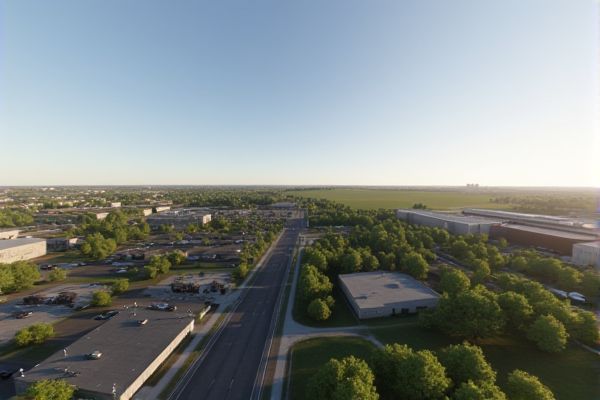
Housing market and best cities to live in North Dakota: Affordable housing options. Fargo's diverse economy. Bismarck's quality of life. Minot's strong community ties. Grand Forks' cultural attractions. West Fargo's growing infrastructure. Dickinson's family-friendly environment. Williston's oil industry impact. Low property taxes. Wide-open spaces advantage.
Affordable housing options.
North Dakota provides a variety of affordable housing opportunities, making it an attractive option for prospective homeowners. Notably, cities such as Devils Lake, Jamestown, and Grand Forks are highlighted for their especially low housing costs. Meanwhile, other cities like Williston and Dickinson also offer comparatively reasonable housing prices. For more information, you can explore The Great North Dakota Affordability Tour, which delves deeper into the most affordable cities within the state, offering insight into housing affordability and community living conditions.
Fargo's diverse economy.
Fargo boasts a diverse and thriving economy with a strong presence in high-tech, healthcare, and education, featuring major employers like Microsoft, John Deere, and North Dakota State University, along with a low unemployment rate and a cost of living below the national average. The city offers a vibrant cultural scene, quality healthcare, and numerous recreational facilities, making it an attractive choice for residents. For more insights on why Fargo, ND is a Best Place to Live, visit the Livability website.
Bismarck’s quality of life.
Bismarck, North Dakota, offers a high quality of life with highly-rated schools, extremely low crime rates, diverse cultures, and friendly neighbors. The city provides a relaxed hometown feel, abundant outdoor activities, and a vibrant downtown with cultural opportunities and a diverse food scene, making it an excellent place to settle down.
Minot’s strong community ties.
Minot, ND, boasts a strong real estate market with significant growth in 2024, characterized by a 16.7% increase in median home prices to $297,500 and homes selling quickly, averaging 41 days on the market. The city’s robust economic performance, job growth, and strong community ties make it an attractive place to live and invest, with a vibrant community known for its energy, agriculture, and military presence. For more detailed insights, visit the Minot ND Real Estate Market Overview.
Grand Forks’ cultural attractions.
Grand Forks offers a rich cultural experience with attractions like the Empire Arts Center, Chester Fritz Performing Arts Center, and the North Dakota Museum of Art, making it a vibrant and welcoming city to live in, with a variety of housing options and a lower cost of living compared to the national average. For those interested in exploring all that this city has to offer, the Arts & Culture scene is not to be missed, providing residents and visitors alike with a unique blend of creativity and entertainment that truly enhances the community experience.
West Fargo’s growing infrastructure.
West Fargo is highlighted for its growing infrastructure, boasting a booming job market with a steady annual growth rate in sectors like Health Sciences, Transportation, and Retail Marketing. With a median home price of $315,074 and an average rent for a one-bedroom apartment at $1,422, the city emerges as an attractive and relatively affordable place to live. Its cost of living is 7% lower than the national average, making West Fargo a compelling choice for those seeking economic growth and livability in North Dakota. For more comprehensive insights, the Houzeo Blog showcases the best places to live in North Dakota.
Dickinson’s family-friendly environment.
Dickinson is highlighted as a family-friendly city in North Dakota, boasting a median home price of $274,789 and a cost of living 20% lower than the state average. With the presence of Dickinson State University, the city also offers a growing job market, affordable housing, and various community amenities. These features make it an ideal place for families and young professionals. For those interested in learning more about the best places to live in the state, the Best Places to Live in North Dakota guide provides valuable insights.
Williston’s oil industry impact.
Williston's oil industry has significantly impacted the local housing market, transforming the town from a small farm community to a bustling oil boom hub. This growth has led to a surge in population, increased housing demand, higher rents, and the need for affordable housing developments to cater to both permanent and temporary workers. Despite challenges such as increased crime and infrastructure strain, the town continues to evolve and adapt to these changes. For more detailed insights into this transformation, you can explore a comprehensive overview on Housing Finance.
Low property taxes.
In North Dakota, the average property tax rate is 0.98%, which is relatively low. A current ballot measure, if approved, could potentially eliminate property taxes on the assessed value of homes, making it an attractive option for those seeking low property taxes. For more information on this significant development, you can visit the Kiplinger website.
Wide-open spaces advantage.
North Dakota's real estate market is characterized by steady appreciation rates, a low unemployment rate of 2.3%, and a robust economic backdrop, making cities like Fargo, Bismarck, and Minot attractive due to their job opportunities, low crime rates, and wide-open spaces that contribute to a high quality of life and active lifestyles. For a more detailed analysis, you can visit the North Dakota Real Estate Market Overview.
